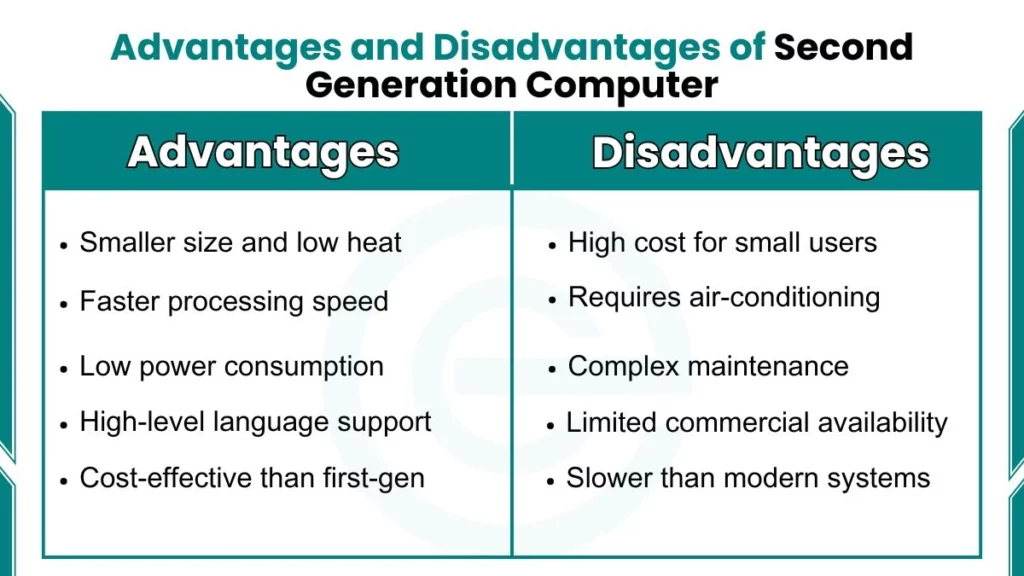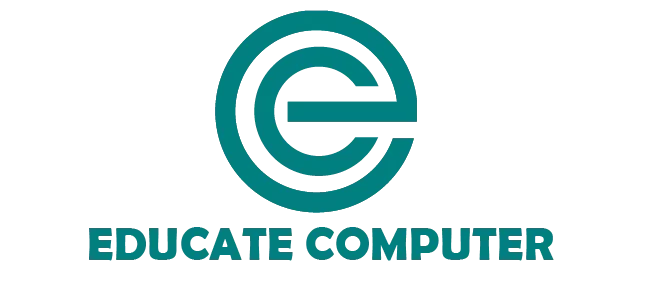Second-generation computers brought important improvements over the first generation by using transistors. They offer better speed, reliability, and efficiency. However, they still have limitations such as high cost and limited portability. Understanding these advantages and disadvantages helps in comparing second generation computers with other generations.

Advantages of Second Generation Computers
Here are benefits of second generation computers:
1. Smaller Size
Second-generation computers became smaller in size because transistors replaced large vacuum tubes. This reduces space requirements and allows better placement inside organizations. These systems generate less heat during operation, which makes them safer and more stable. Due to the reduced heat, cooling requirements also decrease and maintenance becomes manageable.
2. Faster Processing Speed
The use of transistors increases the processing speed of these computers. Transistors switch faster than vacuum tubes, so instructions are executed quickly. This improvement helps in handling larger data in a shorter time. As a result, these computers perform better in scientific, industrial, and business environments.
3. High Reliability and Better Performance
Transistors are more reliable compared to vacuum tubes and fail less frequently. This improves the stability of the system during long hours of operation. Users face fewer interruptions because the failure rate is low. The performance remains consistent, which makes these computers suitable for research and commercial applications. Maintenance becomes easier and system downtime reduces.
4. Lower Power Consumption
Second generation computers consume less power because transistors require very little electrical energy. This reduces operational cost and makes the system more energy-efficient. Organizations benefit from lower electricity usage during continuous operations. The low power requirement also reduces the need for heavy cooling systems.
5. Support for High-Level Programming Languages
High-level languages such as COBOL, FORTRAN, and ALGOL were introduced during this generation. These languages make programming easier and allow users to write complex programs with fewer errors. The presence of high-level language support increases software development capability. This improves the versatility of second-generation systems.
6. More Cost-Effective Than First Generation
Although still expensive, second generation computers cost less than first generation systems. Their smaller size, lower power usage, and reduced maintenance help control the overall cost. This makes them more accessible for universities, industries, and government institutions. The improved efficiency also adds value to the investment. Many organizations adopt these systems for large-scale data processing tasks.
7. Improved Input and Output Devices
Second-generation computers came with improved input and output devices, including punched cards, magnetic tapes, printers, and early disk drives. These devices improve data entry, processing, and storage functions. Users can store large amounts of data and retrieve it efficiently. The I/O operations become faster, which supports a smooth workflow.
Disadvantages of Second Generation Computers
The following are disadvantages of 2nd generation computer:
1. High Cost for Small Users
Although cheaper than first generation systems, these computers are still costly for small businesses and individuals. The manufacturing and installation cost remains high due to advanced components. Skilled operators are required to run the system, which increases operational expense. Only large institutions can afford these computers. This limits their availability to the general public.
2. Require Air-Conditioned Environment
Second generation computers require an air-conditioned environment for stable operation. Even though they generate less heat, their internal components are sensitive and need controlled temperature. Maintaining such an environment increases infrastructure cost. Organizations must arrange proper cooling systems to prevent overheating. This makes installation more complex.
3. Limited Portability
These computers are smaller than first-generation machines but still not portable. They remain large and heavy and need a fixed physical setup. Shifting the system from one place to another is difficult because of its size and wiring. This lack of portability restricts their usage in flexible environments. Only dedicated rooms can support their installation.
4. Complex Maintenance
Maintenance of transistor-based circuits requires skilled technicians. The circuits are delicate and need careful handling during repair. Even though transistors offer better reliability, diagnosing issues still requires expertise. Organizations must employ trained staff for proper maintenance. This adds to the operational cost.
5. Limited Availability for Common Users
Second generation computers are mainly used by industries, research centers, and government agencies. They are not widely available for personal or small-scale use. The high cost, infrastructure needs, and technical requirements restrict their adoption. As a result, only selected institutions use them for data processing. Their reach remains limited during this period.
6. Slower Compared to Modern Systems
These computers are slower when compared to modern generation machines. They cannot perform advanced tasks like graphics, multimedia processing, or real-time applications. The memory capacity and storage options are limited. Their performance remains basic for today’s standards. This restricts their use to simple computational work.
